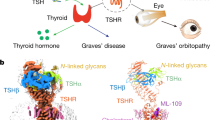Abstract
The α-subunit is common to the heterodimeric glycoprotein hormones and has been highly conserved throughout vertebrate evolution. In an effort to determine if wild-type and engineered human α analogs can serve as agonists or antagonists to the human thyroid-stimulating hormone (TSH) receptor (TSHR), a potent α mutant, obtained by replacing four amino acid residues with lysine (α4K), was assayed and compared with the wild-type α-subunit. When added to CHO cells expressing TSHR, α4K, and to a very limited extent the fused homodimer, α4K-α4K, but not α, exhibited ago-nistactivity as judged by cAMP production. When yoked to TSHR to yield fusion proteins, neither α, α4K, α-α, nor α4K-α4K activated TSHR, although yoked α4K and α4K-α4K were weak inhibitors of TSH binding to TSHR. The yoked subunit-receptor complexes were, however, functional as evidenced by increased cAMP production in cells co-expressing human TSHβ and α-TSHR, α4K-TSHR, α-α-TSHR, and α4K-α4K-TSHR. These results demonstrate that agonists to TSHR can be obtained with α-subunit analogs and suggest that rational protein engineering may lead to more potent α-based derivatives. The differences found between the experimental paradigms of adding free α analogs to TSHR and covalent attachment are attributed to conformational constraints imposed by fusion of the α-subunit analog and receptor, and may suggest an important role for a free (C-terminal) α-carboxyl in the absence of the β-subunit.
Similar content being viewed by others
References
Li, M. D. and Ford, J. J. (1998). J. Endocrinol. 156, 529–542.
Hearn, M. T. W. and Gomme, P. T. (2000). J. Mol. Recog. 13, 223–278.
Hsu, S. Y., Nakabayashi, K., and Bhalla, A. (2002). Mol. Endocrinol. 16, 1538–1551.
Nakabayashi, K., Matsumi, H., Bhalla, A., et al. (2002). J. Clin. Invest. 109, 1445–1452.
Isaacs, N. W. (1995). Curr. Opin. Struct. Biol. 5, 391–395.
Lapthorn, A. J., Harris, D. C., Littlejohn, A., et al. (1994). Nature 369, 455–461.
Wu, H., Lustbader, J. W., Liu, Y., Canfield, R. E., and Hendrickson, W. (1994). Structure 2, 545–558.
Tegoni, M., Spinelli, S., Verhoeyen, M., Davis, P., and Cambillau, C. (1999). J. Mol. Biol. 289, 1375–1385.
Fox, K. M., Dias, J. A., and Van Roey, P. (2001). Mol. Endocrinol. 15, 378–389.
Peng, K.-C., Puett, D., and Brewer, J. M. (1997). J. Mol. Endocrinol. 18, 259–265.
Nemansky, M., Moy, E., Lyons, C. D., Yu, I., and Blithe, D. L. (1998). J. Clin. Endocrinol. Metab. 83, 575–581.
Williams, J. F., Davies, T. F., Catt, K. J., and Pierce, J. G. (1980). Endocrinology 106, 1353–1359.
Wu, C., Narayan, P., and Puett, D. (1996). J. Biol. Chem. 271, 31638–31642.
Narayan, P., Gray, J., and Puett, D. (2000). Endocrinology 140, 67–71.
Narayan, P., Wu, C., and Puett, D. (2000). Methods 21, 59–66.
Narayan, P., Gray, J., and Puett, D. (2002). Mol. Endocrinol. 16, 2733–2745.
Szkudlinski, M. W., Teh, N. G., Grossman, M., Tropea, J. E., and Weintraub, B. D. (1996). Nature Biotech. 14, 1257–1263.
Cetani, F., Tonacchera, M., and Vassart, G. (1996). FEBS Lett. 378, 27–31.
Zhang, M., Tong, P., Fremont, V., et al. (2000). Endocrinology 141, 3514–3517.
Szkudlinski, M. W., Fremont, V., Ronin, C., and Weintraub, B. D. (2001). Physiol. Rev. 82, 473–502.
Leitolf, H., Tong, K. P., Grossmann, M., Weintraub, B. D., and Szkudlinski, M. W. (2000). J. Biol. Chem. 275, 27457–27465.
Yoo, J., Ji, I., and Ji, T. H. (1991). J. Biol. Chem. 266, 17741–17743.
Yoo, J., Zeng, H., Ji, I., Murdoch, W. J., and Ji, T. H. (1993). J. Biol. Chem. 268, 13034–13042.
Chen, F., Wang, Y., and Puett, D. (1992). Mol. Endocrinol. 6, 914–919.
Liu, C., Roth, K. E., Shepard, B. A. L., Shaffer, J. B., and Dias, J. A. (1993). J. Biol. Chem. 268, 21613–21617.
Furuhashi, M., Ando, H., Bielinska, M., et al. (1994). J. Biol. Chem. 269, 25543–25548.
Zeng, H., Ji, I., and Ji, T. H. (1995). Endocrinology 136, 2948–2953.
Liu, C. and Dias, J. A. (1996). Arch. Biochem. Biophys. 329, 127–135.
Xia, H., Chen, F., and Puett, D. (1994). Endocrinology 134, 1768–1770.
Grossmann, M., Szkudlinski, M. W., Dias, J. A., et al. (1996). Mol. Endocrinol. 10, 769–779.
Narayan, P., Meehan, T., and Puett, D. (2003). Biol. Reprod. 68(Suppl. 1), 212–213.
Schubert, R. L. and Puett, D. (2003). J. Mol. Endocrinol. 31, 157–168.
Schubert, R. L., Narayan, P., and Puett, D. (2003). Endocrinology 144, 129–137.
Angelova, K. and Puett, D. (2002). Endocrine 19, 147–154.
Ali, S. A. and Steinkasserer, A. (1995). BioTechniques 18, 746–750.
Agros, P. (1990). J. Mol. Biol. 211, 943–958.
Heikoop, J. C., Van Beuningen-De Vann, M. M. J. A. C. M., Van Den Boogaart, P., and Grootenhuis, P. D. J. (1997). Eur. J. Biochem. 245, 656–662.
Author information
Authors and Affiliations
Corresponding authors
Rights and permissions
About this article
Cite this article
Angelova, K., Fremont, V., Jain, R. et al. Human α-subunit analogs act as partial agonists to the thyroid-stimulating hormone receptor. Endocr 24, 25–31 (2004). https://doi.org/10.1385/ENDO:24:1:025
Received:
Revised:
Accepted:
Issue Date:
DOI: https://doi.org/10.1385/ENDO:24:1:025




